Bending Guide
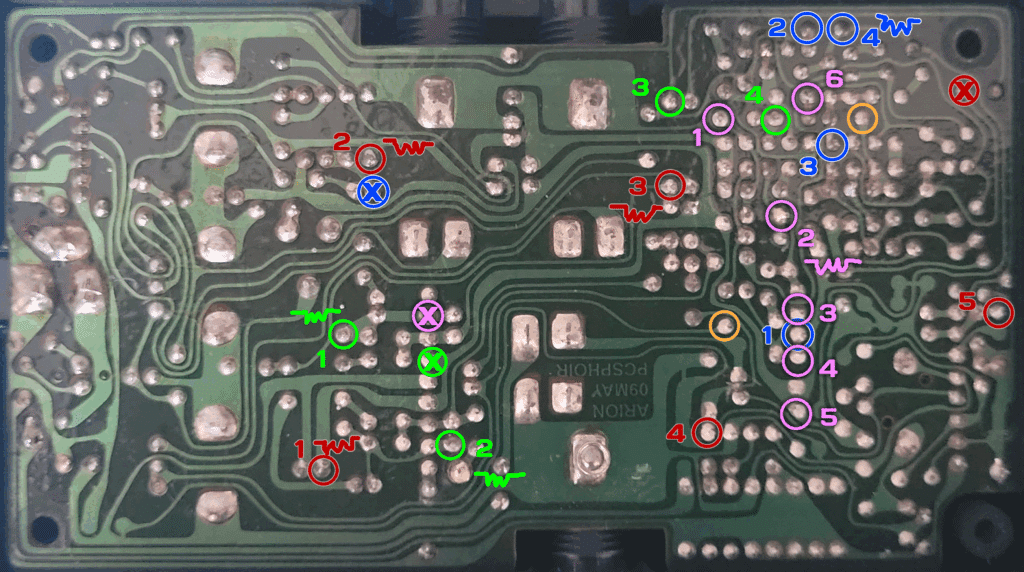
Using This Guide
Bending Guides show specific bends that I have identified as interesting. Color-coded circles indicate separate bending points that all connect to a common point. I call this the Point of Origin (or POO) and indicate the POO with a circle marked with an “X”.
Occasionally a circle will be marked with a zigzag line . This means that I found it useful to add a potentiometer between this point and the POO. These are optional additions–the bend will function just fine with a normal switch.
Suggested Pot Values
- Blue 4 – 1k
- Purple 2 – 500k
- Red 1 – 20k
- Red 2 – 100k
Linear pots work better than logarithmic (audio) pots for these bends.
I appreciate that this is an obnoxious variety of potentiometer values, but these are the values I found gave me the best performance for each bend. If you don’t want to buy a bunch of new pots, just use what you have.
Other Components
On the following bends, I found that a fixed resistor (i.e., a normal resistor, not a potentiometer) helped tone down what was otherwise an overwhelming effect.
- Green 1 – 30 Ohm
- Green 2 – 50 Ohm
- Red 3 – 200 Ohm
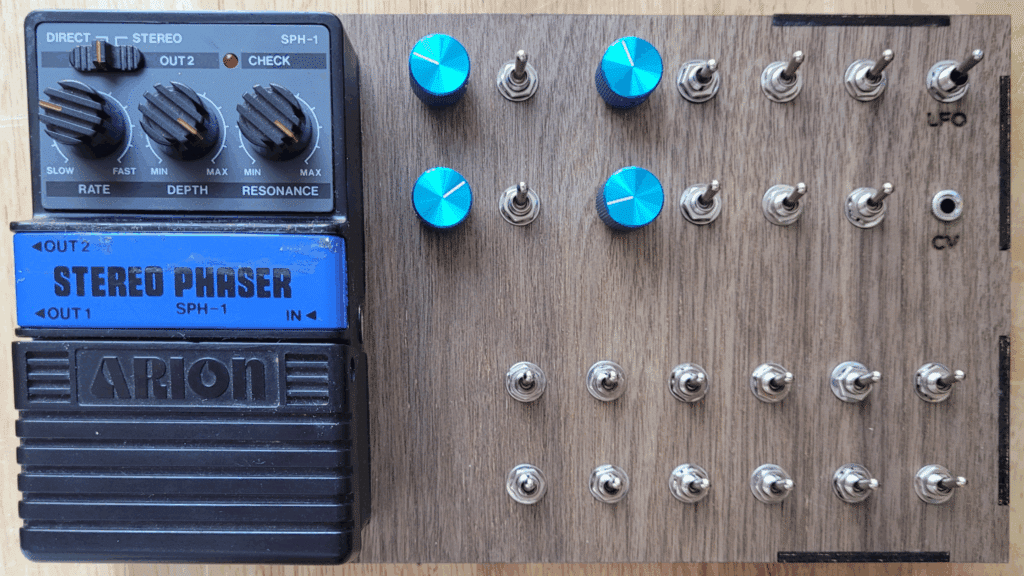
Additional Modifications
I also performed a few mods that I felt were outside my definition of circuitbending, but wanted to share as part of our build.
LFO Range
I replaced the timing capacitor on the internal LFO with two caps, allowing me to switch between LFO rate ranges: one much slower than the factory cap, for longer modulation times; one much faster than the factory cap, for pushing the modulation up into audio rates.
There is an upper limit on the LFO frequency. The phaser stops modulating at a surprisingly low frequency, but it does still get close to usable AM.

The points in the white box connect to C31, the timing capacitor. Remove this capacitor and replace it with the circuit below.
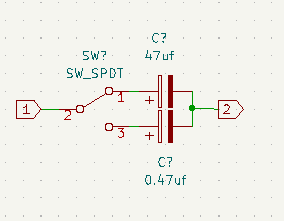
LFO Rate CV
To provide some automation options, I added CV control over the LFO rate.
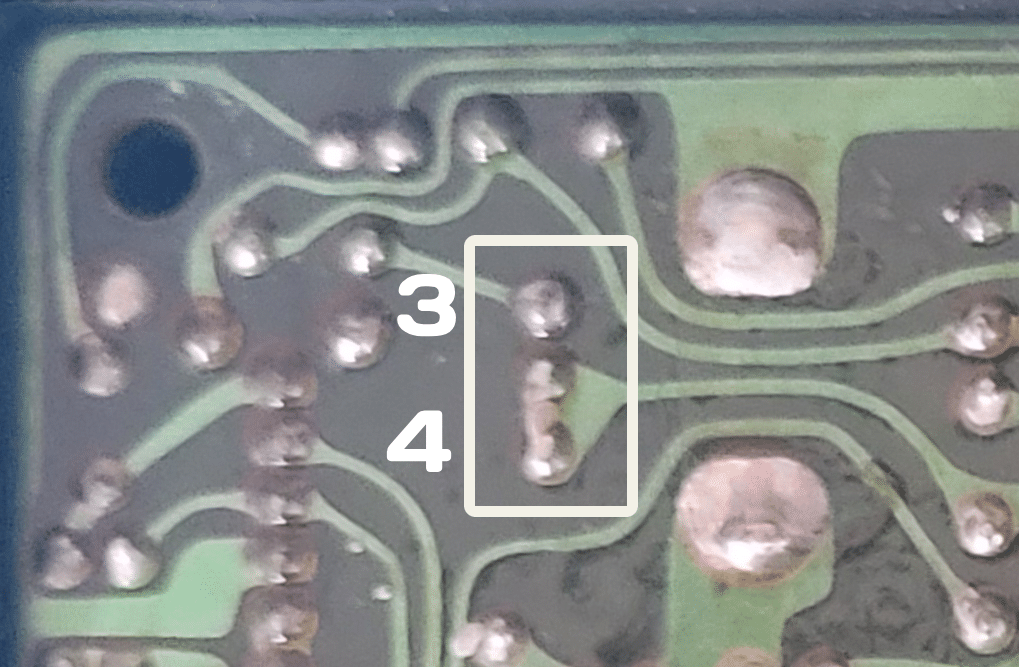
Points 3 and 4 are the legs of the Rate potentiometer. Solder the resistor legs of a vactrol to these points. The bottom two legs of the potentiometer are wired together, so either will work as point 4.
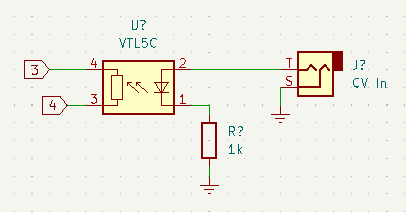
Point 2 of the LFO Range modification connects to the circuit ground. You can use the same point to ground the CV input jack and the 1k resistor.
Built from: Arion SPH-1 Stereo Phaser
Number of bends: 17 20
Description: The most popular build produced by BentPedals.com. The Mutant Phaser boasts 9 distortion bends, 5 modulation bends and 3 tone generation/mod bends.
Loop a patch cord from the input to one of the outputs to create a feedback loop, and use the Mutant Phaser as a stand-alone noise generator.
**New for 2025!**
Overhauling and updating the flagship product from the old BentPedals.com series was an emotionally daunting task. Most of the pedals from that series were built for personal use, but there were about a dozen commissioned Mutant Phasers built and sold 20 years ago.
I approached this project with some trepidation, afraid of both diminishing the value of the old builds and of finding that the reality of this bent pedal doesn’t live up to the memory*.
Fortunately, the pedal does hold up pretty well. Most of the original bends still tickled our fancy today, paying honor to all those Mutant Phasers that might still be floating around out there. While I was less interested in the tone generation bends, I did find a handful of new modulation and distortion effects to add more value as an effect, rather than a stand-alone noise generator.
Admittedly, it’s not the most mind-blowing pedal I’ve revisited this year, but it will certainly find a place amongst the other sound manipulators laying around the Mechlab.
*I mean… Come on. Clearly I’m a sentimental sap, otherwise this whole “let’s revisit a 20-year old project” project wouldn’t be happening.
Demos
The following demos all feature a drum machine running through the CBSP. Each demo starts with a clean signal, then the phaser is turned on, then the bend is connected. There is slight compression and limiting on the signal, but no additional effects.
Blue 1
Blue 2
Blue 3
Blue 4
Green 1
Green 2
Green 3
Green 4
Orange
Purple 1
Purple 2
Purple 3
Purple 4
Purple 5
Purple 6
Red 1
Red 2
Red 3
Red 4
Red 5
Did you build this? Let us know in the comments below!

Leave a Reply